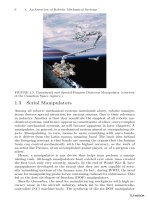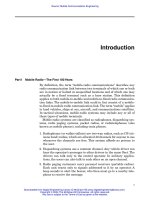Export import theory, practices, and procedures (second edition) part 1
Bạn đang xem bản rút gọn của tài liệu. Xem và tải ngay bản đầy đủ của tài liệu tại đây (1.91 MB, 315 trang )
Belay Seyoum, PhD
Export-Import
Theory, Practices,
and Procedures
Second Edition
Pre-publication
REVIEWS,
COMMENTARIES,
EVALUATIONS . . .
his book covers a number of sig“T
nificant gaps that are not addressed elsewhere. By focusing specifically on trade rather than other forms
of international expansion, Dr. Seyoum
has achieved the near-impossible—indepth and thorough coverage of both
the theory and the practice of exporting, and significantly broader coverage
of importing than is the norm, thus offering the most complete coverage of
all facets of trade that I have seen. It excels by integrating theory with practice
and exports with imports. The fact that
this book starts with a brief history of
international trade and concludes with
a sample distributorship agreement,
speaks to the singular achievement of
this book: true cover-to-cover, and topto-bottom, coverage of all relevant issues in exporting and importing.”
Dr. Nicolas Papadopoulos, PhD
Professor of Marketing and International
Business; Associate Dean (Research);
Director, International Business Study
Group, Eric Sprott School of Business,
Carleton University, Ottawa, Canada
More pre-publication
REVIEWS, COMMENTARIES, EVALUATIONS . . .
nternational Trade has always been
“I
a hands-on subject and the few
books that are out there do not address
anywhere near the width and depth
that Export-Import Theory, Practices, and
Procedures: Second Edition, does. Each of
the twenty chapters in this book closes
with a great summary. The student
here is also provided with enough references, case studies, and international
perspectives on the subject matter covered within the chapter. There are even
review questions for further self-study.
The chapters on import regulations is
especially valuable to the student of international trade and the section on export licensing and regulations of the
Commerce Department is a boon to
any new or seasoned export manager.
The useful presentation of typical import and export transactions as well as
samples of distributor agreements and
business plans put this book way
above any other in its class.”
Ashok Sadhwani, BCom, GDMM, CHB
President and CEO, ASMARA USA INC.;
Instructor, Business and Legal Programs,
UCLA Extension, Los Angeles;
Associate Professor, International Trade,
Chulalongkorn University,
Bangkok, Thailand;
Consultant for the Government
of The Philippines, Airport Cargo
Operations
Export-Import
Theory, Practices,
and Procedures
Second Edition
Export-Import
Theory, Practices,
and Procedures
Second Edition
Belay Seyoum, PhD
First published 2000 by The Haworth Press
This edition published 2009
by Routledge
270 Madison Ave, New York, NY 10016
Simultaneously published in the UK
by Routledge
2 Park Square, Milton Park, Abingdon, Oxon OX14 4RN
Routledge is an imprint of the Taylor & Francis Group, an informa business
This edition published in the Taylor & Francis e-Library, 2008.
“To purchase your own copy of this or any of Taylor & Francis or Routledge’s
collection of thousands of eBooks please go to www.eBookstore.tandf.co.uk.”
© 2000 The Haworth Press
© 2009 Taylor & Francis
All rights reserved. No part of this book may be reprinted or reproduced
or utilised in any form or by any electronic, mechanical, or other means,
now known or hereafter invented, including photocopying and recording,
or in any information storage or retrieval system, without permission in
writing from the publishers.
Trademark Notice: Product or corporate names may be trademarks or
registered trademarks, and are used only for identification and explanation
without intent to infringe.
Cover design by Jennifer M. Gaska
Library of Congress Cataloging in Publication Data
Seyoum, Belay, 1953–
Export-import theory, practices, and procedures / Belay Seyoum,
editor.—2nd ed.
p. cm.
ISBN: 978-0-7890-3419-9 (hard : alk. paper)
ISBN: 978-0-7890-3420-5 (soft : alk. paper)
1. Exports. 2. Imports. 3. Export marketing. 4. International trade. I.
Title.
HF1414.4.S49 2007
382—dc22
2007034264
ISBN10: 0-7890-3419-0 (hbk)
ISBN 10: 0-7890-3420-4 (pbk)
ISBN 10: 0-2038-8930-4 (ebk)
ISBN13: 978-0-7890-3419-9 (hbk)
ISBN 13: 978-0-7890-3420-5 (pbk)
ISBN 13: 978-0-2038-8930-5 (ebk)
ISBN 0-203-88930-4 Master e-book ISBN
CONTENTS
About the Author
Preface
Strengths and Features of this Book
Changes in the Second Edition
Acknowledgments
xiii
xv
xv
xv
xvii
Introduction: A Brief History of International Trade
1
Ancient Period
Colonial Period (1500-1900)
1900 to the Present
1
2
3
SECTION I: OVERVIEW OF INTERNATIONAL TRADE
Chapter 1. Growth and Direction of International Trade
7
Importance of International Trade to the Global Economy
Determinants of Trade
Volume and Direction of Trade
Important Developments in Trade
Chapter Summary
Review Questions
Case 1.1. The Limitations of Export-Led Growth
7
9
9
10
14
15
15
Chapter 2. International and Regional Agreements
Affecting Trade
The GATT and WTO
Regional Integration Agreements (RIAs)
The North American Free Trade Agreement (NAFTA)
The European Union
Chapter Summary
Review Questions
Case 2.1. The Benefits and Costs of Free Trade
19
19
22
25
32
36
37
37
SECTION II: EXPORT MARKETING AND STRATEGY
Chapter 3. Setting Up the Business
Ownership Structure
Business or Trade Name
Bank Accounts, Permits, and Licenses
Location and Use of Professional Services
Organizing for Export: Industry Approach
General Principles of Taxation
Taxation of Export-Import Transactions
International Transfer Pricing
Chapter Summary
Review Questions
Case 3.1. Globalization and the Shrinking Tax Base
Chapter 4. Planning and Preparations for Export
41
41
48
49
49
50
52
54
61
65
66
66
69
Assessing and Selecting the Product
International Market Research
International Market Assessment
Developing an International Business Plan
Export Counseling and Assistance
Overseas Travel and Promotion
Chapter Summary
Review Questions
Case 4.1. Developing Export Markets
69
72
75
77
78
83
91
92
92
Chapter 5. Export Channels of Distribution
95
Indirect Channels
Direct Channels
Locating, Contacting, and Evaluating Agents
and Distributors
Contracts with Foreign Agents and Distributors
(Representatives)
Major Clauses in Representation Agreements
Maintaining and Motivating Overseas Representatives
Chapter Summary
99
105
108
110
110
115
115
Review Questions
Case 5.1. Export Channel Decisions of Two U.S.
Companies
Case 5.2. The Internet and Exporting: A Focus
on Developing Countries
Chapter 6. International Logistics, Risk, and Insurance
International Logistics
External Influences on Logistics Decisions
Typical Logistics Problems and Solutions
The International Logistics Process
Logistics Functions
Risks in Foreign Trade
Marine and Aviation Insurance
Claims and Procedures
Chapter Summary
Review Questions
Case 6.1. Marine Insurance
Case 6.2. Marine Insurance: Inchmaree Clause
116
117
118
121
121
123
125
126
129
131
135
140
145
147
147
148
SECTION III: EXECUTING THE TRANSACTIONS
Chapter 7. Pricing in International Trade
153
Determinants of Export Prices
Pricing in Export Markets
Terms of Sale
Chapter Summary
Review Questions
Case 7.1. Incoterms (CIF)
Case 7.2. Incoterms (C&F)
154
156
158
174
176
177
177
Chapter 8. Export Sales Contracts
179
Harmonization of Contract Law
CISG: Essential Elements
Pertinent Clauses in Export Contracts
Chapter Summary
179
180
185
193
Review Questions
194
Case 8.1. CISG
195
Case 8.2. China National Products versus Apex Digital Inc. 195
Chapter 9. Trade Documents and Transportation
Documentation in Export-Import Trade
Transportation
Air Transportation
Ocean Freight
The Role of Freight Forwarders in Transportation
Chapter Summary
Review Questions
Case 9.1. What Constitutes a Package Under COGSA?
Case 9.2. The Container Revolution
197
197
201
201
205
214
217
219
220
221
SECTION IV: PAYMENT TERMS AND PROCEDURES
Chapter 10. Exchange Rates and International Trade
Foreign Exchange Transactions
Protection against Exchange Rate Risks
Chapter Summary
Review Questions
Case 10.1. Will the U.S. Dollar Maintain Its Key
Currency Status?
Chapter 11. Methods of Payment
Consignment Sales
Open Account
Documentary Collection (Documentary Draft)
Documentary Letter of Credit
Cash in Advance
Other Letters of Credit
Chapter Summary
Review Questions
Case 11.1. Dishonoring Letters of Credit
Case 11.2. The Independent Principle in Letters of Credit
225
225
229
236
236
237
239
239
241
242
247
258
259
265
268
269
270
Chapter 12. Countertrade
Origins of Countertrade
Benefits of Countertrade
Theories on Countertrade
Forms of Countertrade
Countertrade and the WTO
Countertrade and the International Monetary Fund
Governments’ Attitudes Toward Countertrade
Chapter Summary
Review Questions
Case 12.1. The Bofors-India Countertrade Deal
Case 12.2. Offsets in U.S. Defense Trade
271
271
273
274
276
284
285
286
287
290
290
291
SECTION V:
FINANCING TECHNIQUES AND VEHICLES
Chapter 13. Capital Requirements and Private Sources
of Financing
Capital Sources for Export-Import Businesses
Private Sources of Export Financing
Chapter Summary
Review Questions
Case 13.1. Tadoo’s Sales to Belgium
297
299
306
314
316
316
Chapter 14. Government Export Financing Programs
319
Export-Import Bank of the United States (Ex-Im Bank)
Small Business Administration
Overseas Private Investment Corporation (OPIC)
Private Export Funding Corporation
U.S. Department of Agriculture
Chapter Summary
Review Questions
Case 14.1. Trade Finance for Small and Medium-Sized
Enterprises in Transition Economies
Case 14.2. Ex-Im Bank Financing: Selected Cases
320
332
334
337
337
338
340
341
342
SECTION VI:
EXPORT REGULATIONS AND TAX INCENTIVES
Chapter 15. Regulations and Policies Affecting Exports
Export Licensing and Administration
Antiboycott Regulations
Foreign Corrupt Practices
Antitrust Laws and Trade Regulation
Incentives to Promote Exports
Chapter Summary
Review Questions
Case 15.1. Export Trade Certificate of Review
Case 15.2. Enforcement of Export Regulations
347
347
360
363
368
373
377
380
381
383
SECTION VII:
IMPORT PROCEDURES AND TECHNIQUES
Chapter 16. Import Regulations, Trade Intermediaries,
and Services
389
Import Restrictions in the United States
U.S. Free Trade Agreements
U.S. Trade Preferences
Trade Intermediaries and Services
Chapter Summary
Review Questions
Case 16.1. Tax Deduction for Processing in Maquilas:
Mere Assembly or Fabrication
389
394
396
398
403
404
Chapter 17. Selecting Import Products and Suppliers
407
Types of Products for Importation
Finding the Product
What Determines Import Volume?
Selecting the Supplier
International Sourcing
Pricing the Imported Product
Import Marketing Channels
406
407
409
411
412
414
417
417
Financing Imports
Chapter Summary
Review Questions
Case 17.1. The ATA Carnet: Unlocking Customs
for Temporary Entry of Goods
Case 17.2. Maytag’s Triad Strategy
Chapter 18. The Entry Process for Imports
The Entry Process
The Harmonized Tariff Schedule of the United States
Customs Valuation
Rules of Origin and Other Marking Requirements
Chapter Summary
Review Questions
Case 18.1. Deemed Liquidation by Customs
Case 18.2. Product Classification
Chapter 19. Import Relief to Domestic Industry
Antidumping and Countervailing Duties
Antidumping and Countervailing Duty Proceedings
Other Trade Remedies
Chapter Summary
Review Questions
Case 19.1. Similar Products and Dumping
Chapter 20. Intellectual Property Rights
419
420
421
421
423
425
428
432
433
438
439
441
444
445
447
447
453
456
461
462
463
465
What Are IPRs?
IPRs and International Trade
Protection of IPRs
International/Regional Protection
Chapter Summary
Review Questions
Case 20.1. Patents and Access to Lifesaving Drugs
465
468
469
473
476
476
477
Appendix A: Trading Opportunities in Selected Countries
479
Appendix B: Importing into the United States
521
Appendix C: Trade Profiles of Selected Nations (2004)
(Million U.S. Dollars)
531
Appendix D: Average Tariff Rates of Selected Countries
(2002-2004)
535
Appendix E: Ex-Im Bank Programs
537
Appendix F: Sample Export Business Plan: Donga Michael
Export Company
561
Appendix G: Sample Import Business Plan: Otoro Import
Company
567
Appendix H: Export Sales Contract (Basic Clauses)
573
Appendix I: Sample Distributorship Agreement
585
Appendix J: Sample Sales Representative Agreement
593
Appendix K: North American Free Trade Agreement
601
Appendix L: Trade Documents
619
References
627
Index
649
ABOUT
About
THE
the Author
AUTHOR
Belay Seyoum, PhD, is Associate Professor of International Business
Studies at Nova Southeastern University in Fort Lauderdale, Florida, where
he teaches a variety of courses in international business and economics.
Prior to coming to Nova Southeastern, Dr. Seyoum taught international
business at Concordia University and McGill University in Montreal, Canada. Dr. Seyoum has published four books as well as numerous articles in
the area of international trade in several prestigious academic journals such
as the International Business Review, the Journal of World Trade, Multinational Business Review, the International Trade Journal, the Columbia
Journal of World Business, and the Journal of Global Business. He is recipient of the Fulbright Scholar award for 2007 and lives in Florida.
Preface
Preface
This book resulted from the author’s realization of the inadequacy of
existing books to serve the needs of the academic/professional audience.
Most of the books published in this area lack substance and provide only
soft coverage of international trade operations. Another problem is that they
hardly discuss theoretical issues such as the role of exports/imports in the
global economy or pertinent regulatory and policy issues. Current books
are almost exclusively devoted to export activities and provide only cursory
treatment of import processes. Furthermore, most offer no discussion of
current research information in the area.
STRENGTHS AND FEATURES OF THIS BOOK
1. Conceptual and theoretical approach: The book develops a conceptual/theoretical framework to explain international trade operations.
Important scholarly studies are adequately treated in each chapter. Sufficient attention is also given to important legal and policy issues affecting export/import trade.
2. Depth and breadth: The book provides a comprehensive and analytical treatment of pertinent topics in the area. In addition to exports, the
book provides an in-depth examination of import trade. Adequate
coverage is also given to emerging areas such as intellectual property,
countertrade, the role of logistics and transportation, regional trade
arrangements, and so forth. No book on the market comes close in
terms of scholarly substance.
3. Presentation: The book is written in a pedagogically sound manner by
including end-of-chapter summaries, a reference section, and Internet
sources, as well as learning aids such as vignettes, figures, and tables.
CHANGES IN THE SECOND EDITION
1. Current coverage: Important developments in the area of international trade since the publication of the first edition are discussed.
Export-Import Theory, Practices, and Procedures, Second Edition
xv
xvi
EXPORT-IMPORT THEORY, PRACTICES, AND PROCEDURES
This includes, but is not limited to, trends in regional integration
agreements, international transfer pricing, terms of sale, U.S. export
regulations, and export financing programs.
2. Expanded coverage: The book has expanded the coverage of certain
topics, such as taxation of international trade operations, export counseling, export channels of distribution, export sales contracts, transportation, and import procedures and techniques.
3. Review questions and cases: Every chapter summary is followed by
review questions and cases, many of which were written for this book.
4. Learning package: The text is accompanied by instructor’s manual,
test bank, and answers to review questions.
Acknowledgments
Acknowledgments
It would have been impossible to produce this book without the assistance of many people. I would like to thank the leadership team: Dr. Randy
Pohlman, dean; Dr. Preston Jones, executive associate dean; and Dr. Russell Abratt, associate dean at the Huizenga School of Business, Nova Southeastern University, for creating a supportive intellectual environment.
Many thanks to the librarians at the Alvin Sherman library, especially Lia
Hemphill, for opening up their resources. I would like to acknowledge the
valuable research assistance of Bina Patel. I thank her for assisting me in
completing the book and instructor’s manual in time for publication. I also
thank the following people for their helpful feedback on the book: Ralph
Jagodka, San Antionio College, California; Ron Mesia, Microsoft, Florida;
Hoon Park, University of Central Florida; Ashok Sadhwani, Chulalongkorn
University, Thailand; Habte Selassie, University of Bedforshire, UK; and
Randi Sims, Nova Southeastern University, Florida.
This book could not have been written without the help, support, and
encouragement of my wife, Muwen Seyoum.
Writing a book is a major undertaking. However, the reward comes not
only from its publication but from its useful contribution to those in the
field (students, professors, professionals, researchers, etc.), not only in understanding international trade policies and practices, but also in encouraging additional research and dialogue.
Export-Import Theory, Practices, and Procedures, Second Edition
xvii
Introduction:
Introduction
A Brief History of International Trade
ANCIENT PERIOD
International trade based on the free exchange of goods started as early
as 2500 BC. Archaeological discoveries indicate that the Sumerians of
Northern Mesopotamia enjoyed great prosperity based on trade by sea in
textiles and metals. The Greeks profited by the exchange of olive oil and
wine for grain and metal somewhere before 2000 BC.
By around 340 BC, many devices of modern commerce had made their
appearance in Greece and its distant settlements: banking and credit, insurance, trade treaties, and special diplomatic and other privileges.
With the decline of Greece, Rome became powerful and began to expand
to the East. In the first century AD, the Romans traded with the Chinese
along the Silk Road and developed many trade routes and complex trading
patterns by sea. However, the absence of peace made traveling unsafe and
discouraged the movement of goods, resulting in the loss of distant markets.
By the time of the breakup of the Roman Empire in the fifth century, the
papacy (papal supremacy) had emerged as a strong institution in a new and
unstable world. The church’s support (sponsorship) for the crusades in the
eleventh century revived international trade in the West through the latter’s
discovery and introduction of new ideas, customs, and products from the
East. New products such as carpets, furniture, sugar, and spices brought
from Egypt, Syria, India, and China stimulated the markets and the growing
commercial life of the West. This helped Italian cities such as Venice and
Genoa to prosper and to replace Constantinople as the leading center of international commerce. Letters of credit, bills of exchange, and insurance of
goods in transit were extensively used to accommodate the growing commercial and financial needs of merchants and travelers.
By the end of the fifteenth century, the center of international commerce
had moved from the Mediterranean to Western Europe. Spain, Portugal, and
later Holland became the focal points of international commercial activity.
Export-Import Theory, Practices, and Procedures, Second Edition
1
2
EXPORT-IMPORT THEORY, PRACTICES, AND PROCEDURES
The more developed areas of Europe were changing from a subsistence economy to one relying heavily on imports paid by money or letters of credit.
COLONIAL PERIOD (1500-1900)
With the discovery of America in 1492, and sea routes to India in 1498,
trade flourished and luxury goods and food products such as sugar, tobacco,
and coffee became readily available in the markets of Europe.
The principal motivations behind global expansion (colonization) in the
fifteenth century had been to enhance national economic power (mercantilist
policy) by exploiting the colonies for the exclusive benefit of the mother
country. Colonies were regarded as outposts of the home economy that
would reduce trade dependence on rival nations and augment national treasure through exports as well as discoveries of precious metals. This first
phase of colonization, which lasted until the advent of the Industrial Revolution in England in 1750, was characterized by the following general elements with respect to commerce:
1. All commerce between the colonies and the mother country was a national monopoly, meaning all merchandise exports/imports had to be
carried by ships of the mother country and pass through specified ports.
2. Little encouragement was provided toward the development or diversification of indigenous exports. For example, in 1600, precious metals
constituted 90 percent of colonial exports to Spain. In the mid-1650s,
British imports from its colonies were mainly concentrated in three
primary products: sugar, tobacco, and furs. To protect domestic producers, competing colonial exports were restricted or subject to special duties. The patterns of economic relations were fashioned on the
basis of dissimilarity, that is, noncompetitiveness of colonial and metropolitan production.
3. Certain enumerated products could be exported only to the mother
country or another colony. The policy ensured a supply of strategic
foodstuffs and raw materials.
4. Private companies in the metropolis received a charter from the government that granted them (i.e., the companies) a monopoly of trade
in the colonies. In most cases, the charter also granted complete local
administrative authority, ranging from the making of laws and administration of justice to imposition of taxes. Examples of this include the
British East India Company (1600), the Dutch West India Company
(1621), and Hudson’s Bay Company (1670).
Introduction
3
The second historical phase of overseas expansion (1765-1900) was dictated more by commercial considerations than by mere territorial gains.
Britain emerged as the dominant colonial power, and by 1815 it had transformed its empire into a worldwide business concern. By the 1860s, the Industrial Revolution had transformed the social and economic structure of
England, and mass production dictated an expansion of the market for
goods on an international scale. The political economy of mercantilism that
had proliferated over the preceding century was gradually replaced by that
of free trade. By 1860, Britain had unilaterally repealed the Corn Laws,
abolished the Navigation Act restrictions (foreign ships were permitted to
take colonial goods anywhere) and the commercial monopolies given to
particular companies. Preferential duties on empire goods were gradually
abolished. In trade, as in foreign policy, Britain led the free trade ideology
based on nondiscrimination. At the time, Britain was most likely to benefit
from free trade because of its industrial and commercial lead over other
nations.
1900 TO THE PRESENT
The major characteristics of economic relations from 1900 until the outbreak of World War I were the further development of trade and the emergence of a world economy. These were also the result of the international
migration of people and capital from Europe, particularly Britain, since the
1850s, to other countries such as the United States, Australia, Argentina,
Brazil, and Canada. This pattern of world economy provided the industrial
economies with new sources of food and raw materials and new markets for
exports of manufactures. For example, by 1913, Brazil was the source of twothirds of German coffee imports, whereas North Africa supplied over half
of French imports of wine. However, much of the import trade in Europe was
subject to trade restrictions, such as tariffs, to secure home markets for local
producers. Even within Britain there were mounting pressures for the abolition of free trade.
The post–World War I recovery was further delayed by the disruption of
trading links, as new nations were created and borders were redrawn. State
intervention and restrictive economic policies had been consolidated in
Europe and other countries by the end of the war. The U.S. government introduced the Fordney-McCumber Tariff in 1922, which imposed high tariffs
on agricultural imports, and later the Smoot-Hawley Tariff in 1930, which
provoked widespread retaliation. Britain imposed high duties on various
industrial products, such as precision instruments and synthetic organic
4
EXPORT-IMPORT THEORY, PRACTICES, AND PROCEDURES
chemicals, to encourage domestic production under the Safeguarding of
Industries Act, 1921. The volume of world trade in manufactures fell by
35 percent between 1929 and 1932, and prices also fell by a similar amount.
The volume of trade in primary products fell by 15 percent, but prices fell by
about 50 percent. To alleviate the worst effects of the Depression, countries
resorted to more protectionism. This wave of protectionism produced a massive contraction of international trade and further aggravated the Depression. Many of the barriers placed on trade included tariffs and quotas, a
variety of price maintenance schemes, as well as arbitrary currency manipulation and foreign exchange controls and management.
To avoid a repetition of the economic situation of the previous two decades, Allied countries met even before the war to discuss the international
financial arrangements that should govern trade and capital movements in
the postwar world. In 1944, they established the International Monetary
Fund (IMF) and the International Bank for Reconstruction and Development (IBRD). The IMF was to be concerned with facilitating the growth
and expansion of global trade through the system of fixed exchange rates,
while IBRD was established to promote long-term investment. This was
followed by an agreement (the General Agreement on Tariffs and Trade, or
the GATT) in 1948 to permit the free flow of goods among nations.









![[FULL] Verilog HDL : A guide to digital design and synthesis, second edition](https://media.store123doc.com/images/document/2016_04/09/medium_zl0qIgQmGZ.jpg)